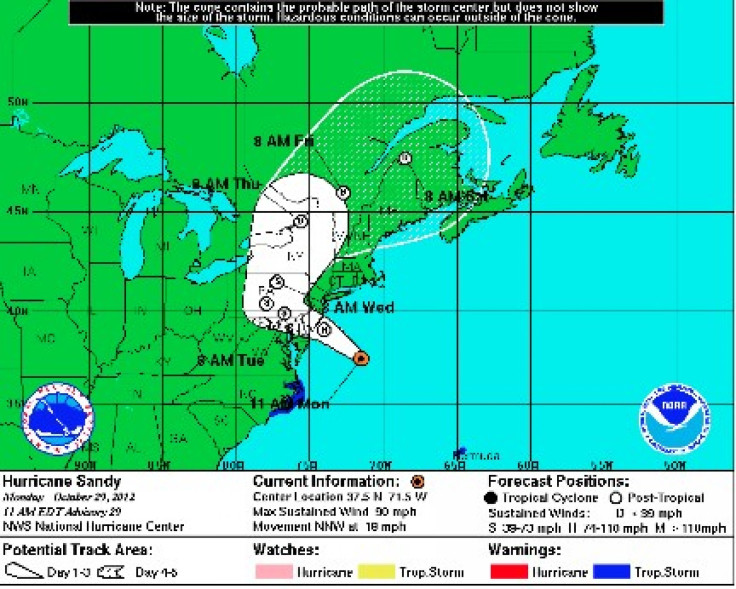Hurricane Sandy’s Path Cancels More Than 10,000 Flights: Update

Hurricane Sandy’s path may take it toward southern New Jersey Monday night, but its effects are already far-reaching as “Frankenstorm” manifests into the Halloween horror many had feared it would be.
By Monday morning, the strengthening hurricane had canceled more than 10,000 flights to and from the Northeast corridor, the most populous part of the United States. Roughly 1,300 of those flights were scheduled for Sunday and 6,814 for Monday, according to Daniel Baker of Houston-based FlightAware. Carriers have thus far axed 2,594 flights for Tuesday, but hundreds if not thousands more cancellations are expected through Wednesday in what analysts say could cost the industry hundreds of millions of dollars.
“Airlines are hoping that they will begin to resume at least some flying Wednesday, but no one can be certain until the storm passes and airports can evaluate the conditions of runways, taxiways, terminals and the roads that serve the airports,” said Henry Harteveldt of Atmosphere Research Group. “The FAA will also have to ensure that all air traffic control centers in areas affected by the storm are safe and functional.”
Most airlines suspended service into and out of airports from Washington to New York Sunday evening, with cancellations spreading further north and inland Monday.
Harteveldt cautioned that airlines already fill 80 to 85 percent of their seats, on average, leaving very little wiggle room to service affected travelers.
“If there's an upside to this storm, it's that it's taking place now and not in three weeks, when everyone is getting ready for Thanksgiving,” he said.
American Airlines ended its service to airports in the mid-Atlantic and Northeast regions at 10 p.m. Sunday night and will not fly in or out until at least mid-day Wednesday, according to spokesman Kent Powell. So far, the carrier has canceled 1,571 flights.
United canceled 3,700 flights or about 16 percent of its trips systemwide through Wednesday. Spokesman Charles Hobart advised customers traveling through East Coast airports in the next week to “sign up for flight status updates at united.com.”
US Airways axed about 1,600 flights, while Delta Air Lines cut some 2,100.
Philadelphia’s airport was the hardest hit with 1,220 cancellations Monday. Each of New York City’s airports, meanwhile, had about 1,000 cancellations.
Carriers timed their suspended service in New York with the closure of the city’s mass transit system at 7 p.m. Both LaGuardia and JFK are in low-lying areas near the water, raising concerns over flooding if storm surges of up to 11 feet hit, as predicted.
Nearly every major domestic airline has a hub at one of the affected airports, and delays have already had a ripple effect across the nation and beyond. On the other side of the Atlantic, London’s Heathrow Airport reported upwards of 60 cancellations Monday due to the storm.
All major airlines have waived change and cancellation fees for trips affected by Sandy -- though altering flight itineraries has not always been easy. Many passengers have complained of hours-long wait times to rebook. Carriers have increased staff at their call centers, but they’ve asked affected customers to try and rebook online.
Airlines typically waive ticket-change fees and cancel flights long before a hurricane arrives to help cut the number of travelers and flight-crew members stranded. Canceling flights well enough in advance also keeps planes out of the way of danger and allows airlines to resume service faster after the storm passes.
Moving planes out of a storm's path is not without its risks as a hurricane’s track can easily change, creating a situation where hundreds of flights are canceled unnecessarily. Given Sandy’s massive size with tropical storm force winds extending nearly 500 miles from the storm center, however, airlines decided that pinpointing where it might make a direct hit was irrelevant.
Those whose flight plans were squashed by the storm will find no luck on the rails either. Amtrak suspended services up and down the East Coast Sunday. On a normal autumn day, some 300 trains would be running.
Regional trains like MARC, Septa, LIRR, Metro North and NJ Transit also suspended most if not all services.
For now, travelers can do little more than sit and wait for Sandy to pass.
© Copyright IBTimes 2024. All rights reserved.












